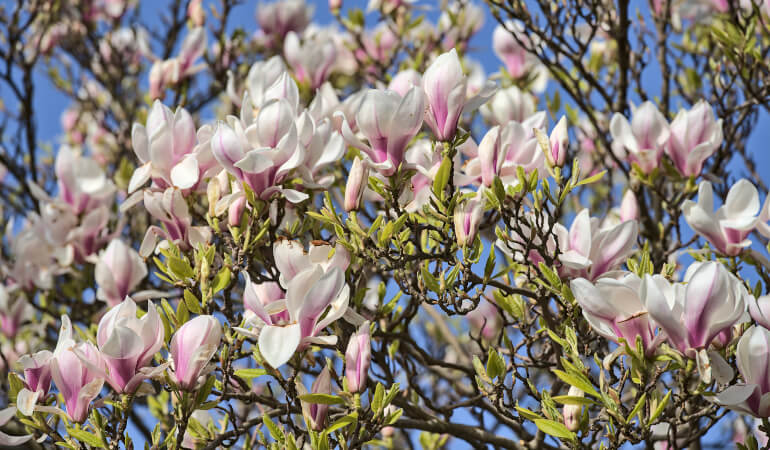
Magnolia trees bring charm and elegance to any garden. Their large, creamy flowers and deep green leaves grab the attention of any passerby easily. But sometimes that doesn’t happen quite so often.
So, let’s ask the question straight, then. Are your magnolia trees not blooming as they used to? Do you fail to understand why?
If you say “yes” to both of these questions, the answer may lie in pruning or the lack thereof. You need to know when and how to prune your magnolias, so they can become healthy and strong again.
So, are you ready to learn just that and help your favourite tree regain its beauty? Good, now read along.
Table of Contents
Magnolia trees’ specifics and pruning significance
There are different types of magnolia trees in the UK, but the Saucer Magnolia and the Star Magnolia are the most common ones.
Star Magnolia stays small, usually under 3 metres. This makes it perfect for smaller gardens. It flowers very early in spring with star-shaped white or pale pink blooms. It prefers a sunny or partly shaded spot with well-drained, slightly acidic soil.
Saucer Magnolia grows broader and taller. It often reaches 6 metres in height or more. It produces large, cup-shaped flowers in shades of pink, purple, or white during spring. It copes well with heavier soils and thrives in full sun.
Keep in mind, there is a difference between a Magnolia tree and a Magnolia bush. Magnolia trees grow tall with clear trunks and wide branches. Magnolia bushes stay smaller and more compact. Both have similar flowers, but differ in size and shape.
Regardless of the type, pruning is essential for Magnolia trees. It removes weak or dead branches and encourages blooming. You also maintain the tree shape, which is also important. When you feed and prune your tree properly, it can last 50 to 80 years. How cool is that?
And not to worry, because you can absolutely prune it yourself if you choose to. But before you do that, you need to know when magnolias bloom because only then can you prune at the right time, which is just as important as how you do it.
When should magnolia trees be pruned in UK?
When to cut back magnolia trees depends on their type.
Deciduous magnolias, such as Star or Saucer Magnolia, should be pruned from mid to late summer. July to September, to be exact. This timing helps prevent sap bleeding and reduces stress on the tree.
Prune evergreen magnolias in early to mid-spring to remove damaged wood or shape young trees. Do this between March and April. Avoid pruning in February or November because then you might hinder the flowering and recovery.
That’s all fine and dandy, you say, but how do I know if my magnolia is evergreen or deciduous? Easy. Just look at its leaves through the seasons.
Evergreen magnolias keep their glossy green leaves all year. The leaves are usually large, thick, and leathery, often with a rusty-brown underside. The tree looks full even in winter.
Deciduous magnolias drop their leaves in autumn. In winter they stand bare, with only their branches visible. Their flowers often appear on bare branches in early spring, before the new leaves grow.
Mind you, you also need to adopt different pruning approaches when you work with young as opposed to mature trees. Prune young magnolias to shape and remove weak branches. Mature trees need careful pruning to remove dead wood, maintain shape, and promote flowering. Avoid heavy pruning in all cases. Magnolias do not respond well to it.
Now you know when to trim a magnolia tree. Let’s discuss what the common signs are that your tree needs to be pruned…
- Dead or diseased branches – Branches that look brown, brittle, or have spots should be removed. This way you prevent disease from spreading.
- Twisting or overlapping branches – These can block light and air. The result will be slower growth.
- Damaged branches – Storms and heavy winds can break branches. Prune them when that happens.
- Overgrown shape – If your tree looks untidy or leans into paths or buildings, prune it lightly to restore its balanced shape.
- Reduced flowering – If you notice fewer blooms than usual, it may signal the tree needs a prune. You already know it will encourage new growth and flower production.
How to prune a magnolia tree in a few steps
Obtain these tools before pruning a magnolia tree
- Secateurs (hand pruners) – For small branches and twigs.
- Loppers – For medium branches that are too thick for secateurs.
- Pruning saw – For larger or tougher branches.
- Protective gloves – To protect your hands from cuts and scratches.
- Eye protection – Useful if you’re cutting overhead branches.
- Disinfectant or rubbing alcohol – To clean your tools before and after pruning, which prevents the spread of disease.
Step 1. Do a detailed check of the tree
Look closely at your magnolia. Find the dead, diseased, or damaged wood. Those are the branches you want to prune. Check for branches that cross or rub against each other as well.
Step 2. Cut dead or damaged wood
Cut all the way back to where the wood is still healthy or right at the natural join. Never leave half-dead bits hanging on. For evergreens, trim weak wood while keeping the tree’s natural shape. For deciduous magnolias, prune just before new growth appears. Avoid cutting the top off the tree all at once. Heavy or hard pruning can stress the tree.
Step 3 – Do some light shaping
Thin crowded areas to improve airflow and light. You can reduce the tree’s height gradually by trimming the upper branches, but never remove more than a third of the tree in one go. Avoid hard pruning or drastic cuts. You don’t need to deadhead magnolias; flowers drop naturally once spent.
Step 4 – Tidy up
Dispose of cuttings in the council green waste bin or compost. Clean tools after use to prevent disease.
How often should I trim a magnolia tree?
Magnolia trees require minimal pruning in most cases. Young ones benefit from light shaping to encourage strong growth. Mature ones only need pruning every few years or to remove dead or damaged branches.
So, to sum it up:
- Deciduous magnolias (e.g. Star, Saucer): Prune in mid- to late summer (July to September), once leaves are fully open. This prevents sap bleeding and reduces stress.
- Evergreen magnolias (e.g. Magnolia grandiflora): Prune in spring (March to April) as new growth begins.
Magnolias are sensitive to heavy cuts. Over-pruning can lead to stress, poor flowering, and slow recovery. Always prune with purpose and know that less is more.
Aftercare tips for your freshly pruned magnolia
Don’t you go thinking you’re done after you’ve pruned your magnolia tree. You need to do some aftercare as well.
- Mulch around the base – Spread a layer of bark or compost to hold moisture and protect the roots. Don’t pile it against the trunk or it may rot. Coffee grounds are fine too, in small amounts, but mix them into compost first so the soil doesn’t turn too acidic.
- Water during dry spells – Give extra water if the weather turns hot or dry. This helps the tree recover from the cuts and supports new growth.
- Hold off on fertiliser – Don’t feed straight after pruning. Wait until spring or early summer when the tree is growing strongly again. That’s the best time to fertilise a magnolia.
- Keep an eye on new growth – Watch for pests, disease, or weak shoots. A mature magnolia needs less fussing than a young one, but regular checks still keep it in top shape.
- Protect from extreme weather – Young trees benefit from shelter against strong wind. Older mature magnolias are usually tough enough to stand on their own.
Do you lack enough time to care for your trees? We don’t, so book your tree pruning today!
Enter your postcode to view our rates and availability in your area.
For questions about the services we offer visit our main site
Takeaways
- Always identify whether your magnolia is evergreen or deciduous. It matters for the best pruning time.
- Prune deciduous magnolias in mid- to late summer and evergreen magnolias in spring.
- Only remove dead, diseased, damaged, or crossing branches.
- Avoid heavy pruning.
- Prune young magnolias lightly to shape them. Mature trees need only occasional pruning, mostly to remove problem branches.



